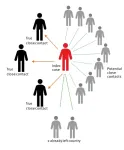(Press-News.org) Researchers have found that a newly developed diet inspired by the eating habits of non-industrialised societies can significantly reduce the risk of a number of chronic diseases – and are to share recipes with the public.
Industrialised diets—high in processed foods and low in fiber— have contributed to a substantial rise in chronic diseases like obesity, diabetes, and heart disease, in affluent countries such as Ireland.
A paper published today in the prestigious scientific journal Cell shows that a newly developed diet that mimics eating habits in non-industrialissed communities led to significant metabolic and immunological improvements in a human intervention study. In just three weeks the diet:
Promoted weight loss
decreased bad cholesterol by 17%
reduced blood sugar by 6%
reduced C-reactive Protein (a marker of inflammation and heart disease) by 14%
These improvements were linked to beneficial changes in the participants’ gut microbiome, the home to trillions of bacteria that play a vital role in our health, influencing digestion, immunity, and metabolism. The research was conducted by an international teams of scientists led by Professor Jens Walter, a leading scientist at University College Cork where he holds a Research Ireland Professorship.. The human trial was performed at the University of Alberta in Canada, Prof. Walter’s previous institution.
“Industrialisation has drastically impacted our gut microbiome, likely increasing the risk of chronic diseases.” explained Prof. Walter, who is also a Principal Investigator at APC Microbiome Ireland, a world-renowned Research Ireland centre
“To counter this, we developed a diet that mimics traditional, non-industrialised dietary habits and is compatible with our understanding on diet-microbiome interactions. In a strictly controlled human trial, participants followed this diet and consumed L. reuteri, a beneficial bacterium prevalent in the gut of Papua New Guineans but rarely found in the industrialised microbiomes.”
The study demonstrated that the new diet entitled NiMeTM (Non-industrialized Microbiome Restore) diet enhanced short-term persistence of L. reuteri in the gut.
However it also improved microbiome features damaged by industrialization, such as reducing pro-inflammatory bacteria and bacterial genes that degrade the mucus layer in the gut. These changes were linked to improvements in cardiometabolic markers of chronic disease risk.
Although participants did not consume fewer calories on the NiMe diet, they lost weight, and the diet alone led to considerable cardiometabolic benefits.
In previous research, the Prof. Walter’s team, studying the gut microbiome in rural Papua New Guinea, found that individuals there have a much more diverse microbiome, enriched in bacteria that thrive from dietary fibre, and with lower levels of pro-inflammatory bacteria linked to western diet. This information was used to design the NiMeTM diet.
The NiMeTM diet shares key characteristics of non-industrialized diets:
Plant-based focus, but not vegetarian: Primarily made up of vegetables, legumes, and other whole-plant foods. One small serving of animal protein per day (salmon, chicken, or pork).
No dairy, beef, or wheat: Excluded simply because they are not part of the traditional foods consumed by rural Papua New Guineans.
Very low in processed foods that are high in sugar and saturated fat.
Fibre-rich: Fiber content was 22 grams per 1,000 calories—exceeding current dietary recommendations.
“Everybody knows that diet influences health, but many underestimate the magnitude”, said Prof. Walter.
Commenting on this study, Prof. Paul Ross, Director of APC Microbiome Ireland, said: “This study shows that we can target the gut microbiome through specific diets to improve health and reduce disease risk. These findings could shape future dietary guidelines and inspire the development of new food products and ingredients, as well as therapeutics, which target the microbiome”.
“The recipes from the NiMe Diet will be posted to our Instagram ( @nimediet ) and Facebook pages, and they will also be included in an online cookbook soon. It is important to us to make these recipes freely available so that everyone can enjoy them and improve their health by feeding their gut microbiome,” said Dr. Anissa Armet from the University of Alberta, a registered dietitian that designed the NiMe diet and one of the lead authors of the publication.
END
New study reveals how a ‘non-industrialized’ style diet can reduce risk of chronic disease
2025-01-23
ELSE PRESS RELEASES FROM THIS DATE:
Plant’s name-giving feature found to be new offspring-ensuring method
2025-01-23
130 years after a fungus-eating plant received its name, a Kobe University researcher has uncovered the purpose of the structure that inspired its name — revealing a novel mechanism by which plants ensure reproduction.
MAKINO Tomitaro, a towering figure in Japanese botany, named around 1,000 species and discovered about 600 new plants between 1887 and 1957. Among his notable discoveries was the diminutive orchid Stigmatodactylus sikokianus, first identified in 1889. After Makino’s discovery, the plant was named for the unique, tiny finger-like appendage (the “dactylus” part) on its stigma, the flower’s ...
Predicting how childhood kidney cancers develop
2025-01-23
Genetically tailored treatment plans for children with a type of kidney cancer could help provide the most effective care while minimising side effects as much as possible.
Researchers at the Wellcome Sanger Institute, Cambridge University Hospitals NHS Foundation Trust, Great Ormond Street Hospital, the University of Würzburg, and their collaborators, have mapped the genetic differences across children with a type of childhood kidney cancer called Wilms tumour.
In about 30 per cent of children with Wilms tumour, there is an inherited genetic change that increases the risk of developing this cancer. This study, published today (23 January) in Cancer Discovery, ...
New optical memory unit poised to improve processing speed and efficiency
2025-01-23
WASHINGTON — Researchers have developed a new type of optical memory called a programmable photonic latch that is fast and scalable. This fundamental memory unit enables temporary data storage in optical processing systems, offering a high-speed solution for volatile memory using silicon photonics.
The new integrated photonic latch is modeled after a set-reset latch, a basic memory device used in electronic devices to store a single bit by switching between set (1) and reset (0) states based on inputs.
“While optical communications and computing have seen significant progress over the past decades, data storage has been predominantly implemented using electronic memory,” ...
World Leprosy Day: Tailored guidelines and reduced stigma needed to tackle leprosy, Irish case study reveals
2025-01-23
A case report published in Eurosurveillance on an adult with an imported case of leprosy in Ireland shows that there are notable challenges in tackling the disease in settings where it is rare. The affected individual was one of five individuals with leprosy reported in Ireland in the past decade. The authors report challenges faced in the public health response due to a delayed recognition of the symptoms by healthcare providers, a lack of specific Irish and European guidelines, and contact tracing in a congregate setting.
Ahead of World Leprosy Day, this case study highlights ...
FAU secures $21M Promise Neighborhoods grant for Broward UP underserved communities
2025-01-23
Despite South Florida’s reputation as paradise, the reality for many is stark. In the 2023-24 school year, Broward County reported more than 6,027 homeless children. The community also faces challenges like chronic absenteeism, mental health issues, poor nutrition, and limited access to quality early learning programs. These factors perpetuate a cycle of poverty and low educational attainment, hindering social mobility and the path to stronger communities.
To help address these issues, Florida Atlantic University has been selected as the recipient of a $21 million multi-year grant from the United States Department of Education Promise Neighborhoods ...
Korea-US leading research institutes accelerate collaboration for energy technology innovation
2025-01-23
The Korea Institute of Energy Research (KIER) signed a Memorandum of Understanding (MOU) with the U.S. Department of Energy’s (DOE’s) National Renewable Energy Laboratory (NREL) on January 9th to collaborate on key carbon-neutral technologies such as solar energy, hydrogen, and energy storage. The MOU was signed virtually via electronic signatures, with KIER President Chang-Keun Yi and NREL Director Dr. Martin Keller serving as the official signatories.
* NREL is a DOE national laboratory focused on the research and development of renewable energy and energy efficiency technologies, energy system integration, and sustainable transportation. NREL ...
JAMA names ten academic physicians and nurses to 2025 Editorial Fellowship Program
2025-01-23
Chicago, January 23, 2025 —JAMA today announces a new cohort of ten academic physicians and nurses selected for the JAMA Editorial Fellowship Program, designed to engage early career clinical or health services researchers with JAMA’s editorial team to learn about editorial decision-making and enhance skills in scientific communication.
Fellows were chosen based on their demonstrated interest in medical publishing, medical education or research, or a career in academic medicine, as well as their communication skills and knowledge of medical research and study design.
The 2025 JAMA editorial fellows are:
Hannah ...
New study highlights role of lean red meat in gut and heart health as part of a balanced healthy diet
2025-01-23
A recent study1 from Purdue University scientists reveals following a consistent dietary pattern that features lean red meat can contribute to gut microbiota balance and support cardiovascular health.
Balanced Diets with Lean Red Meat Support Gut and Heart Health
Researchers in the study assessed the effects of adopting and then intermittently stopping a healthy U.S.-style dietary pattern that included three ounces of lean red meat (beef and pork) daily in healthy young adults, a process called, “dietary pattern cycling.”
The ...
Microporous crystals for greater food safety – ERC proof of concept grant for researcher at Graz University of Technology
2025-01-23
It is a result of his ERC Consolidator Grant-funded project POPCRYSTAL, with which Paolo Falcaro from the Institute of Physical and Theoretical Chemistry at TU Graz has now acquired an ERC Proof of Concept Grant (PoC). The new project called FRESCO, which is being funded to the tune of 150,000 euros over a period of 18 months, aims to increase food safety and reduce food waste. This is made possible by a microporous crystalline composite developed as part of the POPCRYSTAL project, which detects toxic chemical compounds that are produced when ...
Offline versus online promotional media: Which drives better consumer engagement and behavioral responses?
2025-01-23
Marketers today increasingly rely on online platforms like mobile apps, social media, and direct email to deliver promotional content, drawn by their cost-effectiveness and extensive reach. However, despite these advantages, traditional offline promotion, such as printed coupons, might still outperform their digital counterparts in driving consumer behavior.
Offline media are reported to enhance consumers’ ability to recall promotional content and improve their perception of the advertised products. Yet, a direct comparison of how offline and online promotional media affect consumer behavior has remained largely unexplored.
To ...








